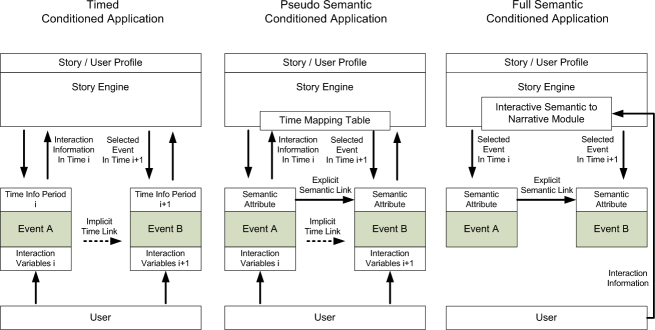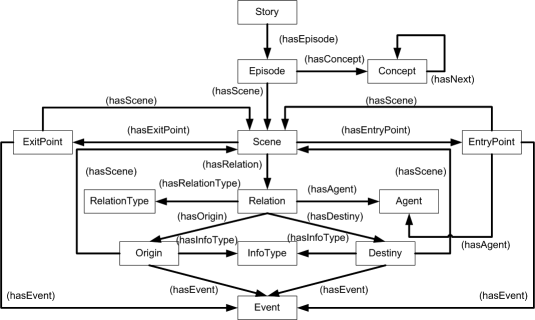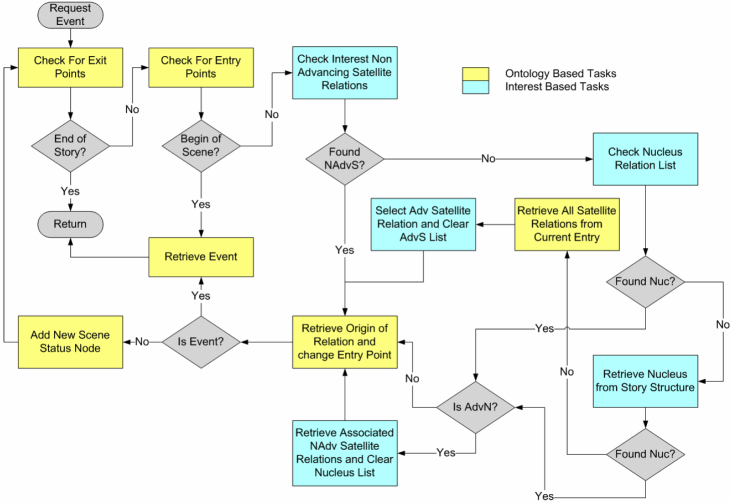ISRST
IRIS Wiki - Computational Models - ISRST
Contents
Background
ISRST (Interactive Storytelling Model using RST, a recent evolution of SRST) proposes an interactive computational model wherein reasoning over an instantiated conceptual framework is informed by interactive input, which is not directly mapped to model constituents, but rather mapped to dynamically changing global and local (i.e., agent-specific) criteria for the selection of the next presentation unit of the story (and thus also its evolution). ISRST promotes a strict separation of concerns, keeping the visual presentation aspects distinct from event sequencing determined by story reasoning carried out over an ontological structure. The design of this ontological structure draws heavily upon RST (Rhetorical Structure Theory) but deviates based on experiences gathered with SRST to (better) accommodate desiderata of interactive storytelling.
Description
ISRST proposes what the authors term a "full semantic conditioned" storytelling model based on the organisation of events using a selection of rhetorical relations identified by Rhetorical Structure Theory and narrative principles. The authors distinguish the "full semantic conditioned" storytelling model from the "timed conditioned" and "pseudo-semantic conditioned" applications models, where explicit (wall-clock) timing information is included in the modelling and user manipulations are mapped directly to reified interaction variables that are constituent part of the model (see figure below).
Quality of experience provided by "timed conditioned" models is prone to issues arising because of the inherently only contingent relation of timing information and interaction variables (as opposed to semantically grounding devices). These issues are addressed, but only to a limited extent, in so-called "pseudo-semantic conditioned" models, where (typically: rhetorical) semantic event relations are mapped to spatio-temporal relations by means of a fixed set of rules. Thus, "pseudo-semantic conditioned" models on the one side eliminate the use of timing information attributes, if with limited means; but on the other they still do include interaction variables directly in the definition of events, thereby interfering with the purpose of explicit semantic relations.
In contrast, "full semantic conditioned" models are characterised by allocating interaction variables defined in the story events within the very story engine, eliminating altogether their potential to establish temporal relations (even if implicitly). This comes at the cost common to any forsaking of "shallow modelling", in particular the renouncing of the possibility to patch limitations of the model (which includes not only making up for fundamental limitations of scope of the modeling approach, but also the option to provide cheaper "good enough" solutions for parts of the model of very limited overall impact). In addition, deployment of "full semantic conditioned" models requires also to provide alternative interaction devices, in terms of both, the identification of useful qualities defining the coupling of the user to the story's evolution, and the providing of practical solutions, including the ensuring of users' understanding of the capabilities and responsibilities they are endowed with and assigned to, and the providing of suitable engineered solutions in terms of user interface devices. For this latter challenge, the authors of ISRST build upon the concept of user interest as proposed by Ed Tan as key performance evaluation criterion of story experience.
The ISRST modelling approach comprises formal specifications of the central notions of: story event (a minimum unit by which a story or part of it can be told; due to presumed high inter-application variation, any more detailed formalisation of this entity is considered out of scope of the model) and related semantic relations selected from the set relation types covered in rhetorical structure theory (RST); story concept networks defining the directed dependency links between scenes or episodes (allowing to identify existing logical transitions required for a smooth flow of knowledge along a dynamically generated concept path); agents and related points of view (capturing the possibly differing subjective relevancies of events for different agents); and nucleus and satellite events: necessary and optional elements of the interactive presentation of the story.
The ISRST ontology model comprises the classes of "Concept" (a specific topic that a story or a part of it may refer to); "Event" (the unit of information presentation); "Relation" (a rhetorical binding between two event or scene entities expressing a specific semantics); "Origin" and "Destination" defining the position of an event or scene in a given relation; "Agent" (a story entity used as target of user interest, see the concluding critical notes); "Scene" (a minimal organisation of relations, expressed as a graph); "Episode" (the object associating a scene and a concept); and "Story" (the framing of a whole story in terms of one or more episodes). Additional attributes and annotations are provided by auxiliary classes: the single "EntryPoint" and possibly multiple "ExitPoint"s of a scene; the "RelationType" name of a relation; and the "InformationType" of the content of origin and destiny object of a relation (in terms of nucleus or satellite).
The scene class is one of the main changes introduced with ISRST over its predecessor SRST. It marks the departure from the tree-based organisation of related events inherited from RST to overcome experienced issues in both, content creation (regarding flexibility and clarity for the author) and support for interactivity (in terms of variety of even selection, in particular regarding the possibility of having multiple entry and exit points).
Application to Interactive Storytelling
In addition to the organisational aspects covered so far, ISRST also implements two narrative principles describing how a story is to be presented. The concept of "Advancing the Story" identifies locally whereto the current position of a story can change, based on "advancing" relation instances anchored to the current story position (in particular, the "CAUSE" relation from RST does not figure among the advancing relations, since disclosure of the cause of a given state does not by itself necessarily advance the story). This concept is applied in a backward chaining manner to a given graph structure created by the relation objects of a particular scene, to establish the conditions by which the scenes may be traversed.
At a global level, ISRST follows a fixed narrative structure articulated in terms of story phases, each of which may be introduced only by a specific rhetoric relation: story introduction (initiated by the non-advancing BACKGROUND relation), story conflict (initiated by the advancing CONTRAST relation), story resolution (initiated by the advancing SOLUTIONHOOD resolution), and story conclusion (initiated by the advancing EVALUATION relation).
Event sequencing
Reasoning on instantiated ISRST models is informed by loosely coupled user feedback regarding their currently perceived interestingness of the story (cf. Tan). Such input is computationally mapped to two derived values used to direct ontological reasoning: estimated overall interest, which relates to the degree of "user stimulation" in terms of density of present events (which are themselves classified by whether they are story-advancing or not), and identification of user's sympathy in specific characters. These values are used by "Interest based tasks" in the event selection process, as depicted in the following figure.
Examples
The website http://ninfort.com/isrst/isrst.html provides online access to "When Your Heart Takes Over", a full-length implementation of an ISRST-based interactive story that is playable on a Java enabled Web browser.
Critique
The view of storiness implemented in ISRST is strongly centred on individual characters, as clearly exposed by the interpretation of user interest feedback in terms of agent empathy and the related promotion or demotion of candidates in the selection of events to be presented. Such a stance misses out on the large narrative potential of aesthetic emotions related to dynamic configurations of multiple characters, as argued in Greg Smith's analyses of TV series, such as Seinfeld or Ally McBeal. Therein, Smith explains how user interest need not necessarily be rooted in any individual character, and conversely how even and exactly the performance of characters considered uninteresting can instrumental for the staging of encompassing situations which the user may very well be interested in. Furthermore it is shown how the traditional characterisation of the realm of satisfactory user experiences in terms of "heroes actively pursuit and reaching of their goal states" can be expanded in a principled fashion.
References
- Nakasone, A. & Ishizuka, M. (2006). SRST: A Storytelling Model using Rhetorical Relations. Third International Conference on Technologies for Interactive Digital Storytelling and Entertainment, TIDSE 2006, Stringer LNCS 4326, Darmstadt, Germany, pp. 127-138.
- Nakasone, A. & Ishizuka, M. (2006). ISRST: An Interest based Storytelling Model using Rhetorical Relations. Proc. Edutainment 2007, Springer LNCS 4469, Hong Kong, China, pp. 324-335, 2007
- Nakasone, A., Prendinger, H. & Ishizuka, M. ISRST: Generating interesting multimedia stories on the Web, Applied Artificial Intelligence, forthcoming.


